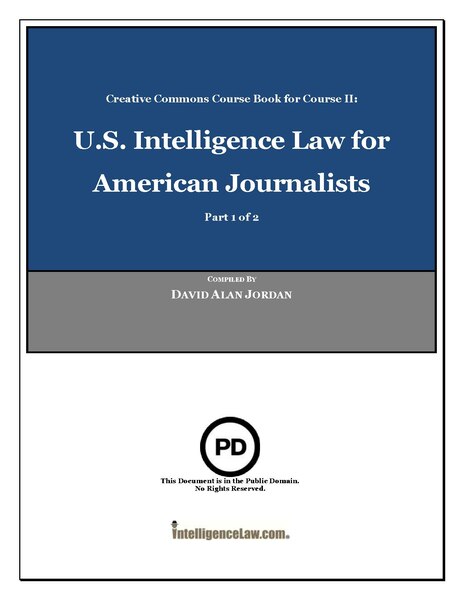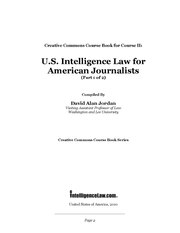English: This mammoth, 2169-page desk reference contains an extensive selection of many of the most useful CRS reports on various intelligence law topics arising under all relevant titles of the United States Code. The content is organized to correspond directly with the U.S. Code in order to facilitate the use of this course book not only during a student's legal education but also later on in legal practice. Throughout the lecture component of Courses I and II students become familiar with the structure of intelligence law in the U.S. Code. Once a student learns where to find all of the codified statutes controlling various issues presented by intelligence activities they will be able to refer to this desk reference for valuable background material on many of the most important statutory issues that arise in U.S. intelligence law.
This course book was so large, I had to divide it into 2 separate volumes when uploading it to the Wikimedia Commons:
Part I is 1332 pages and contains background reports on intelligence law topics arising under statutes codified in Titles 1-49 of the U.S. Code. It has everything from the Freedom of Information Act in Title 5 all the way down to CALEA in Title 47.
Part II is 843 pages and contains background reports on intelligence law topics arising under the statutes codified in Title 50 of the U.S. Code. Title 50 contains the two framework statutes that constitute the heart of U.S. intelligence law:
1) 50 U.S.C. Chapter 15 contains the National Security Act of 1947, as amended; and
2) 50 U.S.C. Chapter 36 contains the Foreign Intelligence Surveillance Act of 1978, as amended.
I have selected many excellent background reports on all Title 50 issues ranging from "Gang of Eight" reporting for covert actions all the way down to the new retroactive immunity for telecommunications companies that participated in the NSA's warrantless surveillance program. This second volume is essential reading for any American who would like to master U.S. intelligence law.
I have created both of these volumes to be placed immediately into the public domain, so feel free to use or distribute them however you like.
David Alan Jordan



